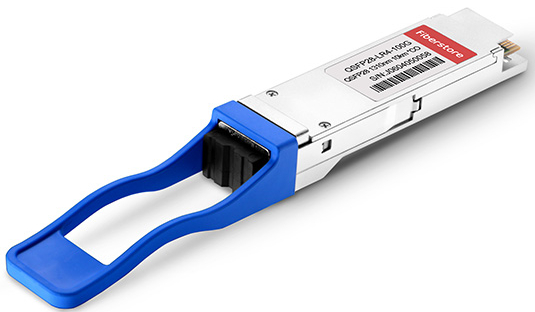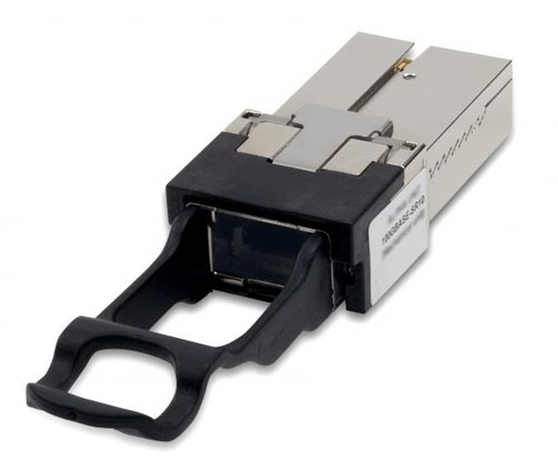Network has been rapidly developed over the years. People are always dreaming of entering into the world of higher bandwidth. And now the dream has come true since we already reach the 100 gigabit Ethernet (100 GbE) networking. This technology enables the transmission at rates of 100 gigabits per second (100 Gbit/s). The standard was first defined by the IEEE 802.3ba in 2010. To accommodate the trend, different types of 100G optical transceiver emerge as a reflection of the development. QSFP28 (quad small form-factor pluggable 28), CFP (centum form-factor pluggable) and CXP (centum extended-capability form-factor pluggable) are most commonly used optical transceiver solutions for 100G active equipment. Today, the article will mainly introduce these three solutions.
100G Transceiver Solutions
CFP
Specified by a multi-source agreement (MSA) between competing manufacturers, CFP was designed to replace many former transceivers like SFP+, SFP, XFP with a significantly larger support of 100 Gbps. The electrical connection of a CFP uses 10 x 10Gbps lanes in each direction (RX, TX). The optical connection can support both 10 x 10Gbps and 4 x 25Gbps variants. In addition, there are another two CFP next-generation 100G form factors — CFP2 and CFP4. Compared to the existing CFP, CFP2 and CFP4 are respectively double and quadruple front panel port density. All of them are now available on the market.

QSFP28
QSFP28 transceiver is designed for 100G Ethernet which uses the 4 x 25 wiring specification. It has the same size as 40G QSFP+ but with a higher performance. The 100G QSFP28 is implemented with four 25Gbps lanes. “28” stands for the highest possible rate of 4x28Gbps in transmission. Two basic versions of QSFP28 transceivers are 100GBASE-SR4 QSFP28 transceiver and 100GBASE-LR4 QSFP28 transceiver, which are respectively used for multimode fiber (MMF) and single-mode fiber (SMF) 100G applications. 100GBASE-SR4 QSFP28 operates at multimode fiber for a distance of 100 m. 100GBASE-LR4 QSFP28 can support a much longer distance of 10 km.

CXP
As a complement to CFP, CXP is also specified by MSA aiming at the clustering and high-speed computing markets. CXP has a higher density network interface with 45 mm in length and 27 mm in width, making it slightly larger than an XFP or 1/4 size of a CFP transceiver. It has a form-factor pluggable active device interface with 12 transmit and 12 receive lanes, capable of supporting bit-rates in excess of 10 Gbps per lane on a variety of optical transmission technologies.

Future Trend of Optical Transceivers in Data Centers
In the future, higher bit rates over 100G are the inevitable trend in data centers. The next data center developments will be following the 4x trend set by 40G and 100G, such as 200G, 400G, etc. Accordingly, optical transceivers should keep up with the steps and satisfy higher demands.
In 200G applications, next generation switching ASICs (Application Specific Integrated Circuits) are expected to have native port speeds of 50G and 128 ports, which correspond to a net throughput of 6.4 Tbps. This means that 200G QSFP modules (QSFP56, 4 x 50 Gbps) would result in a front panel bandwidth of 6.4 Tbps (32 x 200 Gbps).
For 400G applications, the module must accommodate either 16 x 25G or 8 x 50G electrical input lanes, which exceeds the 4 lanes defined for the QSFP. 400G transceivers will have larger size than QSFP. However, meeting the 3.5W power limit of QSFP modules appears infeasible for some 400G implementations. Thus, proposals for larger form factors for 400G can be anticipated from CFP MSA, which has had large success in 100G with CFP, CFP2, and CFP4. In this case, a key requirement will be that the size allows for at least 16 ports on the front panel in order to satisfy a net throughput of 6.4 Tbps (16 x 400 Gbps, and possibly more).
Conclusion
The market of 100G optical transceivers is accelerating. It is no doubt that more 100G transceivers and other assemblies will be deployed in data centers. QSFP28, CFP series and CXP are presently the most suitable solutions for 100G applications. Definitely one of them can solve your project needs.
没有评论:
发表评论